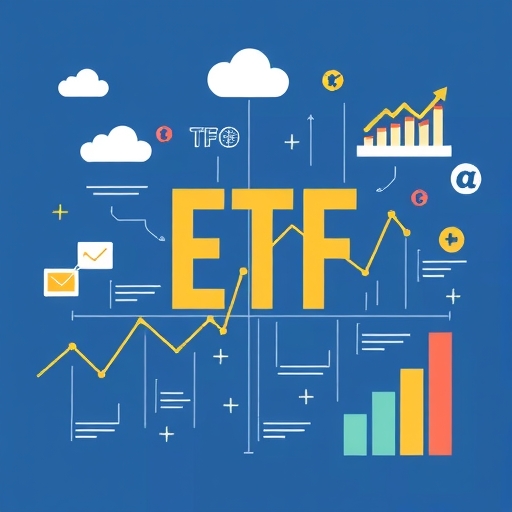Mastering the Metrics: Tracking Error, Direct Indexing, and the Future of Personalized Portfolios
Have you ever wondered how closely your investment truly follows the market benchmark it aims to track? In today’s sophisticated financial landscape, investors are seeking not just returns, but also precision and control over their portfolios. Two critical concepts, Tracking Error and Direct Indexing, stand at the forefront of this evolution. Tracking Error, a fundamental measure of how much an investment’s returns deviate from its benchmark, is essential for evaluating passive strategies like Exchange-Traded Funds (ETFs) and even active management. Direct Indexing, an increasingly popular and advanced approach, leverages individual security ownership to offer unparalleled customization and tax efficiency. This article will demystify tracking error, explore its various facets and causes, and illustrate how it intersects with the transformative power of direct indexing to empower investors with more tailored and tax-optimized outcomes. We will guide you through understanding these concepts, their importance, and how they shape modern investment strategies.

Unpacking Tracking Error: The Core Measure of Benchmark Alignment
What exactly is Tracking Error? Simply put, it’s a quantitative measure that tells us how closely a portfolio’s returns have followed its chosen benchmark’s returns over a specific period. Imagine you’re driving a car trying to stay exactly on a painted line on the road. Tracking error is like the wobbles and deviations you make from that line. In the world of finance, a low tracking error means your investment fund or portfolio has done a great job of staying aligned with its benchmark, while a higher tracking error indicates a greater divergence.
We typically calculate tracking error as the standard deviation of the differences between the portfolio’s returns and the benchmark’s returns over time. For example, if a fund aims to track the S&P 500 index, we would compare the fund’s daily or monthly returns to the S&P 500’s daily or monthly returns. The variability of these differences then gives us the tracking error. This metric is crucial for evaluating passive investment strategies like index funds and ETFs, where the primary goal is often to replicate the benchmark’s performance as accurately as possible.
There are primarily two types of tracking error:
- Ex-Post (Realized) Tracking Error: This is a backward-looking measure. It quantifies the historical deviations between a portfolio’s returns and its benchmark’s returns. Fund managers and investors use ex-post tracking error to report past performance and assess how well a fund has historically replicated its index. It tells us what *has happened*.
- Ex-Ante (Predicted) Tracking Error: This is a forward-looking estimate of potential future deviations. Based on current portfolio holdings, their weights, and their historical relationship (covariance) with the benchmark’s components, ex-ante tracking error helps portfolio managers predict how much their portfolio might deviate from the benchmark in the future. It’s used for portfolio optimization and risk assessment, helping managers make adjustments to keep future deviations in check.
Understanding both types is key. While ex-post tells us about past consistency, ex-ante helps us predict and manage future performance, especially when making strategic changes to a portfolio or constructing a Direct Indexing solution.
The Hidden Costs of Deviation: Causes and Impact of Tracking Error
Why do portfolios deviate from their benchmarks? There are numerous factors that can cause Tracking Error, even for funds specifically designed to mimic an index. These causes can accumulate, leading to a noticeable difference in performance over time.
Minimizing tracking error is a critical objective for investors for several reasons:
- It ensures that the investment strategy accurately delivers the intended market exposure, reducing surprises in performance relative to the chosen benchmark.
- Lower tracking error often correlates with a more efficient management process, indicating that a fund or portfolio is effectively balancing costs and replication accuracy.
- For passive investors, consistently low tracking error provides confidence that their investment is truly mirroring the market, aligning with their long-term strategic asset allocation goals.
Understanding these benefits helps underscore why portfolio managers and investors alike pay close attention to this metric.
Here are some common causes:
- Management Fees and Expenses: All investment funds, including ETFs and mutual funds, charge fees for their management and operation. These costs are deducted from the fund’s assets, creating a consistent drag on returns that the benchmark doesn’t experience. This is often a primary contributor to a fund’s Tracking Difference (the absolute performance gap), which is related to but distinct from tracking error.
- Cash Holdings (Cash Drag): Funds often hold a small percentage of their assets in cash for liquidity purposes, to cover redemptions, or to facilitate new investments. This uninvested cash doesn’t participate in market gains, creating what’s known as “cash drag” and contributing to tracking error.
- Portfolio Composition Differences (Sampling): It can be impractical or too expensive for a fund to hold every single security in its benchmark, especially for broad market indexes with thousands of stocks. Instead, many funds use a “sampling” technique, holding a representative subset of the index. While efficient, sampling can lead to minor deviations if the sampled portfolio doesn’t perfectly mirror the index’s performance.
- Timing of Trades and Rebalancing: Indexes are rebalanced periodically (e.g., quarterly) to reflect changes in their underlying components or weights. Funds tracking these indexes must also rebalance their portfolios. The timing of these trades, the prices at which they are executed, and transaction costs (commissions, bid-ask spreads) can all introduce tracking error.
- Market Liquidity: In less liquid markets or for very large trades, it might be difficult for a fund to buy or sell securities at the exact desired prices, leading to deviations from the benchmark’s theoretical pricing. This is particularly true for certain asset classes like bonds or smaller-cap stocks.
- Corporate Actions: Events such as mergers, acquisitions, stock splits, or dividend payments require adjustments to a fund’s portfolio. The timing and execution of these adjustments can also contribute to tracking error.
- Regulatory Constraints (e.g., UCITS): Some regulations, like the Undertakings for the Collective Investment in Transferable Securities (UCITS) in Europe, impose limits on how much a fund can invest in a single security. This can prevent a fund from perfectly replicating a highly concentrated benchmark, leading to “structural tracking error.”
The impact of tracking error can be significant. Even small, consistent deviations can compound over time, leading to substantial differences in investor returns compared to the benchmark. A high tracking error for a supposedly “passive” fund can indicate higher risk or an unreliable replication strategy, potentially leading to investor disappointment. For this reason, investors often use tracking error as a key metric when comparing the effectiveness of different ETFs or index funds designed to track the same benchmark.
Direct Indexing: A New Paradigm for Precision and Personalization
In contrast to traditional index funds and ETFs, Direct Indexing presents a more granular and highly customizable approach to passive investing. Instead of buying shares of a fund that holds many stocks, you directly own the individual stocks that make up an index. This strategy, once largely reserved for institutional investors, is now increasingly accessible to individual retail investors, driven by advances in technology and a demand for personalized financial solutions.

What makes direct indexing so compelling? It offers several distinct advantages:
- Unparalleled Customization: With direct indexing, you’re not constrained by a fund’s pre-packaged portfolio. You can tailor your portfolio to reflect personal values, such as Environmental, Social, and Governance (ESG) preferences, or even specific thematic investments. Do you want to exclude certain industries or companies? Direct indexing allows for that level of personalization, ensuring your investments align with your beliefs.
- Advanced Tax Management (Tax-Loss Harvesting): This is arguably the biggest draw of direct indexing. By owning individual stocks, you gain control over the “cost basis” of each security. This allows for sophisticated Tax-Loss Harvesting (TLH) strategies, where you can sell individual stocks at a loss to offset capital gains or even a portion of ordinary income. These harvested losses can then be used to reduce your current or future tax burden, effectively generating “tax alpha” – an increase in after-tax returns that wouldn’t be possible with a traditional fund.
- Efficient Management of Concentrated or Appreciated Positions: If you have highly appreciated stock from an employer or have inherited a concentrated position, direct indexing can help you gradually diversify out of these holdings while strategically harvesting losses from other parts of the portfolio, minimizing capital gains taxes.
- Asset Location Optimization: Direct indexing facilitates more precise asset location strategies, allowing you to place tax-inefficient assets (like bonds) in tax-deferred accounts and tax-efficient assets (like growth stocks with capital gains potential) in taxable accounts.
While direct indexing offers immense benefits in personalization and tax efficiency, it also introduces complexity. Managing numerous individual securities requires robust technology and expertise in portfolio rebalancing, trading, and tax rules (like wash sale prevention). This is where technology platforms and financial advisors play a crucial role in making direct indexing accessible and manageable for the average investor.
To further illustrate the differences between traditional index funds/ETFs and direct indexing, consider the following comparison:
| Feature | Traditional Index Fund/ETF | Direct Indexing |
|---|---|---|
| Ownership | Shares of a fund (collective ownership of underlying securities) | Direct ownership of individual underlying securities |
| Customization | Limited (fixed by fund’s mandate) | High (personalized exclusions, factor tilts, ESG integration) |
| Tax-Loss Harvesting | Fund-level only (not passed to individual investors) | Individual-level (highly effective for tax-alpha generation) |
| Minimum Investment | Generally lower (can buy single shares of ETF) | Higher (requires buying many individual stocks) |
| Complexity/Management | Low for investor (managed by fund) | High for investor (often requires technology platform/advisor) |
This table highlights how direct indexing offers a more granular and potentially more advantageous approach for certain investors, particularly those with higher assets, concentrated positions, or specific tax management needs.
Minimizing Tracking Error in Direct Indexing and ETFs: Strategies for Optimal Performance
Whether you’re investing in a traditional ETF or building a personalized Direct Indexing portfolio, the goal of matching a benchmark’s performance as closely as possible, and thus minimizing Tracking Error, remains paramount. How do fund managers and direct indexing platforms achieve this?
For traditional index funds and ETFs, the strategies typically involve:
- Full Replication vs. Optimized Sampling: For benchmarks with a manageable number of securities (e.g., the S&P 500), funds often aim for full replication, holding every stock in the index at its exact weight. For broader indexes, they may use optimized sampling, selecting a subset of securities that statistically represents the index’s performance with minimal tracking error.
- Minimizing Transaction Costs: Fund managers strive to reduce trading expenses, including commissions and bid-ask spreads, as these directly contribute to tracking error. This might involve using sophisticated trading algorithms or trading in larger blocks.
- Efficient Rebalancing: When the benchmark rebalances, the fund must follow suit. Efficient rebalancing minimizes market impact and transaction costs. This often involves planning trades strategically over a period rather than executing all at once.
- Securities Lending: Some ETFs engage in securities lending, where they lend out a portion of their holdings to generate additional income. While this can help offset fees and reduce tracking error, it also introduces a small amount of counterparty risk.
In the realm of Direct Indexing, managing tracking error takes on a slightly different nuance due to the emphasis on personalization and tax efficiency. While the core principle of matching the benchmark remains, the individual portfolio might deviate more deliberately for specific client goals. Here’s how tracking error is managed:
- Algorithmic Trading and AI: Modern direct indexing platforms heavily rely on algorithmic trading and Artificial Intelligence (AI). These technologies enable efficient trade execution across many individual securities, minimizing slippage and market impact. AI can optimize rebalancing decisions, identifying the best times and ways to buy or sell securities while keeping the portfolio aligned with its benchmark and simultaneously looking for tax-loss harvesting opportunities.
- Optimized Portfolio Construction: Direct indexing solutions often use sophisticated optimization engines. These engines balance the goal of tracking the benchmark with other client-specific objectives, such as ESG exclusions, factor tilts (e.g., value or growth), or managing concentrated positions. The system aims for the lowest possible tracking error while adhering to these constraints.
- Continuous Tax-Loss Harvesting: Instead of just rebalancing periodically, direct indexing platforms continuously monitor individual security prices. If a stock drops below its purchase price, the system can automatically harvest that loss, sell the security, and immediately replace it with a highly correlated alternative to maintain market exposure and minimize tracking error, while avoiding “wash sales.”
- Customization Within Bounds: While personalization is key, direct indexing platforms ensure that customization doesn’t lead to excessive tracking error. For example, if you exclude an entire sector, the system might reallocate funds to closely related sectors to maintain the overall risk and return characteristics of the benchmark as much as possible.
By combining robust technology with strategic portfolio management, both traditional ETFs and advanced direct indexing solutions strive to minimize tracking error, ensuring that your investment experience aligns as closely as possible with your chosen market benchmark.
Beyond the Basics: Tracking Error, Tracking Difference, and Advanced Analysis
As we delve deeper into investment performance, it’s important to clarify the distinction between Tracking Error and Tracking Difference, two related but distinct concepts often discussed when evaluating index-tracking investments.

Here is a summary of their key characteristics:
| Metric | Definition | Focus | Primary Influences |
|---|---|---|---|
| Tracking Error (TE) | Standard deviation of the differences between portfolio and benchmark returns. | Consistency/Volatility of deviation. | Portfolio composition differences, trading costs, market liquidity. |
| Tracking Difference (TD) | Annualized performance gap (portfolio return – benchmark return). | Absolute over/underperformance. | Management fees, expenses, cash drag. |
Understanding both TE and TD provides a comprehensive view of how well an investment tracks its target index.
* Tracking Error (TE): As we’ve discussed, this measures the volatility or consistency of the difference between a portfolio’s returns and its benchmark’s returns. It’s the standard deviation of those differences. A low tracking error indicates that the fund’s performance consistently stayed close to its benchmark, even if it consistently lagged slightly (due to fees, for instance). It tells you about the *variability* of the deviation.
* Tracking Difference (TD): This is a direct measure of the annualized performance gap between the fund and its benchmark. It’s simply the fund’s return minus the benchmark’s return over a period, often expressed as an annualized percentage. Tracking difference primarily reflects the impact of fees, expenses, and cash drag. For example, if an S&P 500 ETF has a 0.05% expense ratio, its tracking difference will likely be around -0.05% annually, assuming perfect replication otherwise. It tells you about the *absolute* over or underperformance.
Think of it this way: Tracking error is about how “wobbly” the line is, while tracking difference is about how “far below” the line the average performance sits. Both are crucial metrics for assessing an ETF’s or Direct Indexing portfolio’s effectiveness. A well-managed index fund should have both a low tracking error (consistent performance relative to the index) and a low tracking difference (minimal drag from fees and other costs).
Real-Life Examples: ETFs and Tracking Error
Let’s consider popular ETFs like the Vanguard Total Stock Market ETF (VTI) or the SPDR S&P 500 ETF (SPY). Both aim to track broad market indexes (the CRSP US Total Market Index for VTI and the S&P 500 for SPY). Despite their excellent reputations for low fees and tight tracking, they still exhibit small but measurable tracking errors.
For instance, SPY might have a tracking error of 0.05% to 0.10% annually, and a tracking difference very close to its expense ratio (around 0.09%). This small deviation can arise from:

- Minor differences in dividend reinvestment timing compared to the index.
- Fractional share differences or very small cash holdings.
- The impact of transaction costs when the fund rebalances.
These tiny differences, while seemingly insignificant over a day or week, can lead to measurable performance gaps when compounded over many years. This is why investors scrutinize these metrics carefully.
Advanced Analysis for Deeper Insights
For those who want to dive deeper, advanced statistical methods can provide even richer insights into tracking error:
- Regression Analysis: This can help identify specific factors that contribute to tracking error.
- Time-Series Analysis: Useful for understanding how tracking error changes over different market cycles or economic conditions.
- Monte Carlo Simulation: Can be used to model various scenarios and predict the probability of different levels of future tracking error (ex-ante).
- Factor Analysis: Helps uncover underlying risk factors that might be causing deviations.
When considering Direct Indexing, it’s important to understand the practical aspects of its implementation.
| Consideration | Description | Impact on Investor |
|---|---|---|
| Minimum Account Size | Requires sufficient capital to buy a broad basket of individual stocks. | May not be suitable for small portfolios due to trading costs and diversification needs. |
| Technology Platform | Relies on sophisticated software for rebalancing, trading, and tax-loss harvesting. | Access to efficient tools is crucial for managing complexity effectively. |
| Advisory Fees | Often managed by financial advisors or robo-advisors who charge fees. | Fees can offset some tax benefits if not carefully managed. |
| Wash Sale Rules | Requires careful management to avoid disallowed losses when re-buying substantially identical securities. | Automated systems are essential to navigate these complex tax rules. |
These sophisticated tools are often employed by fund managers and quantitative analysts to fine-tune portfolio construction and rebalancing strategies, whether for large-scale ETFs or highly personalized Direct Indexing portfolios, always with the aim of delivering the best possible outcome for investors.
Conclusion
Tracking error is more than just a statistical anomaly; it is a critical indicator of investment precision and management effectiveness, especially in the context of index-tracking strategies like ETFs and the increasingly popular Direct Indexing. From the subtle drag of management fees to the complexities of market liquidity and rebalancing, numerous factors can cause a portfolio to deviate from its benchmark. Understanding these causes and their impact is paramount for any investor seeking to align their portfolio with their financial goals.
As direct indexing continues to gain traction, offering unprecedented levels of customization and tax efficiency through strategies like tax-loss harvesting, understanding and actively managing tracking error becomes even more crucial. By embracing sophisticated tools, strategic portfolio management, and a keen awareness of both historical (ex-post) and predictive (ex-ante) deviations, investors can harness the power of direct indexing to build portfolios that not only aim for benchmark-like returns but are also meticulously tailored to their individual financial situations, ultimately maximizing after-tax wealth over the long term.
Frequently Asked Questions (FAQ)
Q: What is the primary difference between Tracking Error and Tracking Difference?
A: Tracking Error measures the volatility or consistency of a portfolio’s deviation from its benchmark, expressed as the standard deviation of return differences. Tracking Difference, on the other hand, is the absolute annualized performance gap, primarily reflecting expenses and cash drag.
Q: How does Direct Indexing help with tax efficiency?
A: Direct Indexing allows investors to own individual securities, enabling sophisticated tax-loss harvesting. This strategy involves selling individual stocks at a loss to offset capital gains or ordinary income, thereby reducing the investor’s tax burden and potentially generating “tax alpha.”
Q: Can a fund have a low tracking error but still underperform its benchmark?
A: Yes, a fund can have a low tracking error if its performance consistently stays close to its benchmark, even if it consistently lags slightly due to factors like management fees. In this scenario, it would have a low tracking error but a negative tracking difference.
Disclaimer: This article is intended for informational purposes only and does not constitute financial advice. Investing in financial markets involves risks, and past performance is not indicative of future results. Always consult with a qualified financial professional before making any investment decisions.



No responses yet